Next to prostitution, forgery may be mankind’s oldest profession. Humans fuck, humans copy. Reproduction is implicated in both. Sculpture molds partake in the ethic of reproduction; reproduction is a flesh trade and transaction. A mold is a tool of forgers. Sculpture molds are ersatz wombs. Presenting sculpture that evokes the mold is like presenting the uterus instead of the child.
Mold sculptures emanate their power of reproduction, ably pointing to their ancestry and to their potential simultaneously. Mold sculptures are matrixes, neither figure nor ground, but exposing their structural precondition as womb, mold, die.1Unused and unusable (presented as pristine sculpture, these inflexible molds would not release a casting if used), these molds forestall the sadness of an emptiness. Functioning as double representations, reflections, or doppelgangers, they allow a questioning of narcissism’s claim to immortality; and this deployment of the matrix allows an eroding of the form from within, “the action of which is disruption, disarticulation, dysmorphia.”2On the other hand, post-studio artists, such as Daniel Buren, annihilate the studio: “The art of yesterday and today is not only marked by the studio as an essential, often unique, place of production; it proceeds from it. All my work proceeds from its extinction.”3 Let the battle between reproduction and extinction begin.
Being mold-obsessed, I noticed a resurgence of interest in molds while touring the galleries in London last fall. I am talking about the kind that sculptors use, the kind with negative space begging to be filled. Three sculptors—Klaus Weber, Evan Holloway and Giuseppe Penone—don’t exactly employ molds as much as deploy the semblance of molds and present the form of the void as finished works. This inverted operation enlarges our ideas and conversation on semblance and copy, of repetition as artwork or practice, and of the place and nature of void in a very material-based and morphologically committed practice.
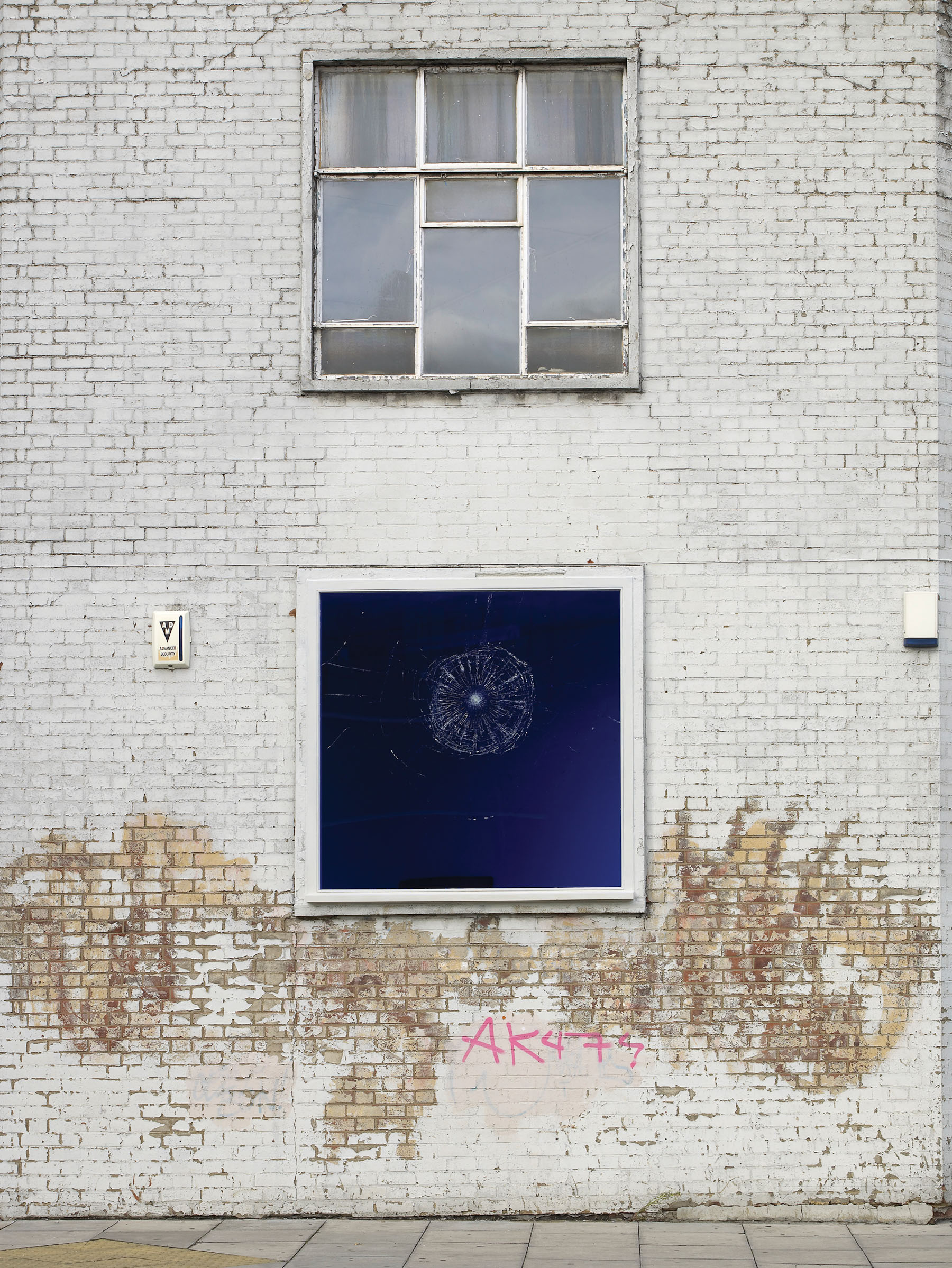
Klaus Weber, Untitled Broken Window, 2012. Colored safety glass, 67.3 × 69.9 inches. Courtesy Herald St, London, and Andrew Kreps.
In the weak October light of London, I strode beneath a blue window shattered like a spider web (Untitled Broken Window, 2012) into Herald St gallery, walked past a prefabricated fountain spouting dry sand (Sandfountain, 2012) into a small room, where I saw Untitled Vitrine (2012), another Klaus Weber piece. This glass vitrine displayed, from left to right, a colorful anatomical model of a human abdomen sans organs resized to the scale of a human face (Klaus had once imagined a face when confronted with an organ-less cadaver); a silicone mold from a facial cast (of a psychiatric patient killed on a bicycle escape from the asylum); a plaster cast positive from the mold of the death mask; and a locust with human hair for antennae (a tribute to a dead grasshopper that Weber found outside his studio). The surface is traded anonymously; each body is presented as object, seemingly unrelated and nonequivalent to the one adjoining it.
You wouldn’t know all the backstories without reading the press release. You would simply feel the impact of the catachrestic lesson in forced and inexplicable mixed metaphors: Medical education. Fake blue and red plastic blood vessels. Fake science. Hallucinations. Neoclassical death mask. Commemoration. Escape. The plaster copy refusing the departure of the dead. Inevitable loss of organs and senses. Human hair as antennae to baffle self, to irritate others. Antennae as physical projection for sensory intake. Mold as armature for understanding the living in death. A mold as sculpture. As casket. A vitrine as reliquary.
The lesson seems to be that one might tweak what exists to understand what doesn’t.4The organ-less abdomenface and the hairantennae grasshopper bracket the evidence of the death mask. The lesson tells us something about how sculpture is the act of making bodies. Inside the artist’s studio is the mold; outside the studio is the sculpture. Outside the studio door is a dead grasshopper. Look again and repeat: All bodies fall equally fast. That’s Weber’s title for his show. The logic is impeccable. The mold of a singular dead man’s face is the pivot because it is the only thing that is cast directly from a human body, that contains the void, and that points to the body as absented, as something missing. The other components are cris de coeur of the befuddled medical student and the sculptor emerging from his studio.
For Untitled Vitrine, and for the works by Holloway and Penone that I will address, a question arises: Could a sculpture mold capture the fact that bodies are singular; the fact that they appear and disappear too? Could the possibility of infinite repetition without actually producing any copies allow transgressions in the material world, allow a way forward beyond the dialectic of reproduction and extinction, between the studio-based and the non-studio-based artists’ intellectual commitments?
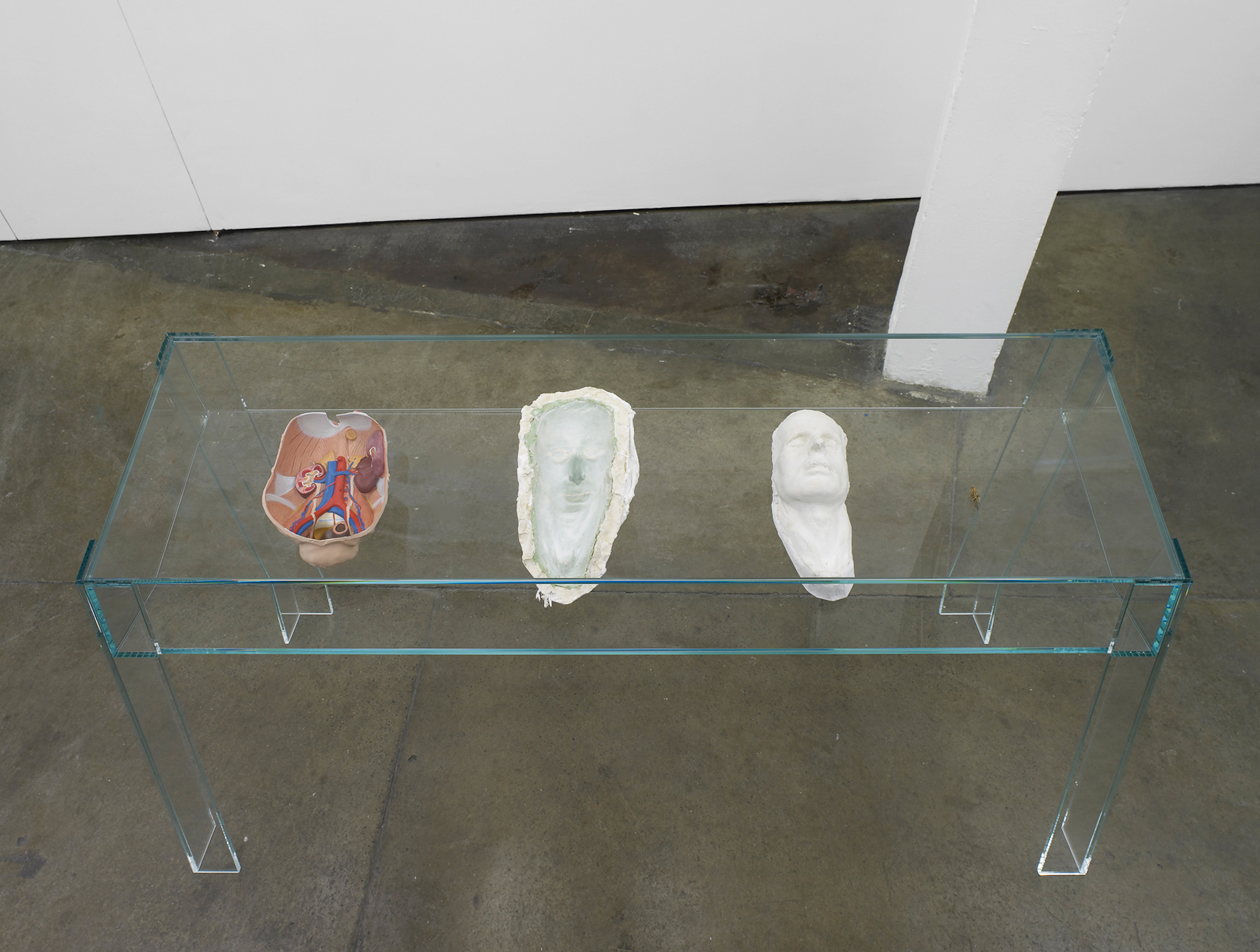
Klaus Weber, Untitled Vitrine, 2012. Plastic anatomical model, silicone mold andplaster cast of a death mask, grasshopper with human hair antennae, glass vitrine; 36.2 × 22.6 × 67 inches. Courtesy Herald St, London and Andrew Kreps.
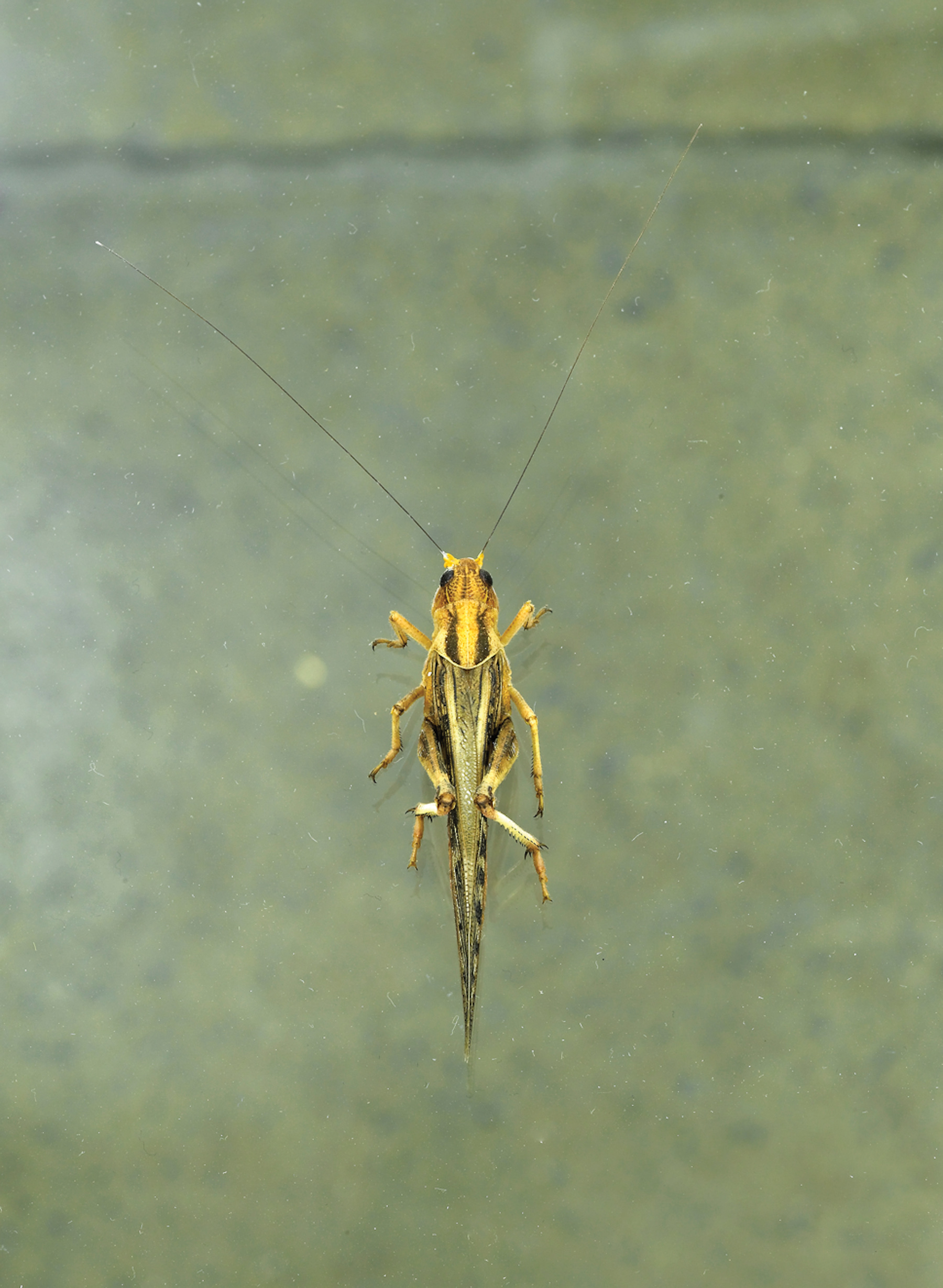
Klaus Weber, Untitled Vitrine (detail), 2012. Courtesy Herald St, London and Andrew Kreps.
If inside a studio is the mold and outside is the sculpture, Evan Holloway reversed those distinctions for his fall exhibition at The Approach. He included three pieces from 2012 that caught my interest: Gates #1, Two Brooms, and Double David. Gates refers to the ducting by which molten material is introduced into a mold. Holloway rescued two waste bronze gates with attached sprues from being scrapped by placing them atop an enigmatically painted mica and steel table, anchoring l’informe to a very real studio practice. These are gates into his practice of post-process plunk, also the title of his show.
Post-process is not the same as post-studio. Holloway’s post-process has a stake in the studio as well as the final work, but is not invested in the originality and novelty of the creative in-studio experience. Plunk is to set down hard, as with the weight of a commitment or a challenge. Process is resolved as a final image; and valuing the final image and its meaning is an act of post-process plunk.
In Double David and Two Brooms—both of which are made from a twice repeated half of a notional two-part mold—Holloway has, figuratively speaking, put quotation marks on either side of what he has appropriated with his dual molds. One mold implies infinity, but what do two molds facing each other imply? It stops us short. It is no longer merely about unrealized potentials. Two molds produce an excess, a surplus that brings into play all the baggage of dualism and narcissism, the latter a psychological fortress against death and the former an argument against the supremacy of material in art. Either way, for Holloway the idea reigns supreme, and the work is not made for its material affects, even though they might add to an interpretation.

Evan Holloway, Double David, 2012. Bronze, 98.5 × 19 × 16 inches. Edition of 3. Courtesy of The Approach. Photo: Robert Wedemeyer.
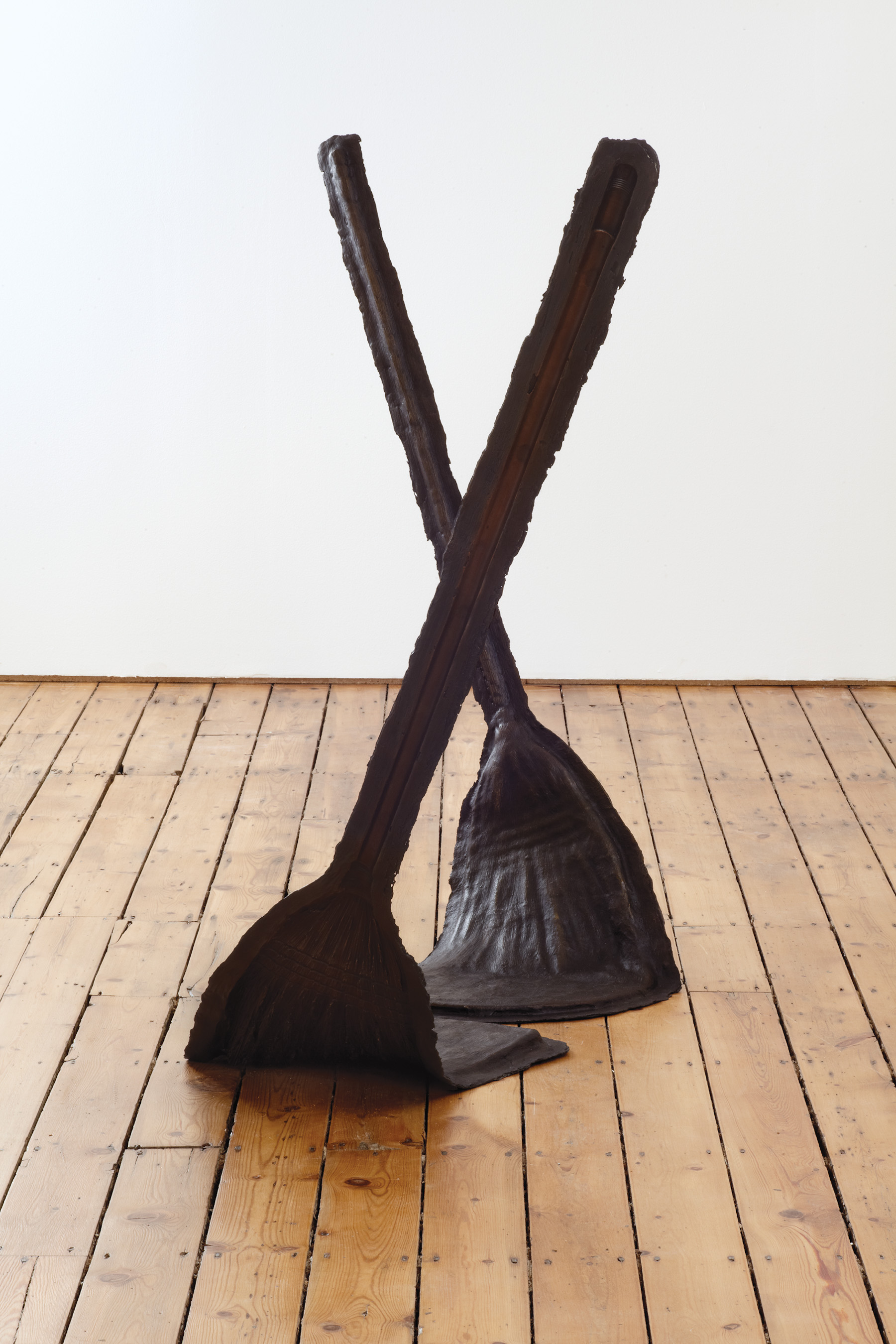
Evan Holloway, Two Brooms, 2012. Bronze, 42.1 × 80.3 × 24.4 inches. Edition of 3. Courtesy of The Approach. Photo: FXP photography.
Double David takes one of the ubiquitous scaled down copies of Michelangelo’s marble statue, makes two thin shell molds of the front half, and joins them vertically feet to feet. Did I mention the molds are made of bronze? Which is to say, they are inflexible and hence are unusable as molds. The mold is symbolic, indicative, indexical, anything but functional. They are truly negative-space sculptures with a glossy polished inner finish, as if that is the obverse, and with a rough soft-featured outer surface as if that is the reverse. They both point to the single surface that is missing: Double David may be the title, but it is David who is absent. The work also cleverly converts Michelangelo’s David into a readymade via the intermediary of a garden copy. This metonymic mold is Art imitating art imitating Art: a sculptural surface stolen from an already compromised shrunken copy of a well-recognized masterpiece that is already doubled as a copy in situ in Florence while the “original” sits in a museum devoid of context.5If the role of a mold is to copy, to point to the potential kitschy castings of Davids, then this mold succeeds by failing, by remaining resolutely incomplete and uncompletable.
Two Brooms again pairs identical half molds of a broom, mid-sweep, magically aloft in a chiastic duet, cleverly indicating forces that are unseen—the hands that hold it, the floor that is being serviced, the force that bends the brushes of the broom and the gravity that holds them in space. Grounding, levitating, these are witchy matters. The ordinary is made strange.6 After Duchamp, we cannot help but see this double negative as subverting the function of a readymade: the original found objects do not stand on their own here as sculpture but are marked as absent.
Does Holloway mean anything by his choice of found subjects? A broom, a garden copy of David—are they supposed to be things that fascinate equally?7 This is the ethos of not believing in a superior subject. And yet, the Michelangelo David is no less a glorious sculpture after Holloway’s operations, the garden David is still upmarket kitsch, and the original broom no less a functional tool.
Note that neither source broom nor Ur-David was made with a mold like a bronze sculpture is. A factory worker bound the brush. Michelangelo chipped at stone. Michelangelo would not have used a mold anyway since he was no realist.8Holloway is a realist, if in an appropriative mode, and he represents the fruits of these labors, both artistic and artisanal, in the form of a negative imprint or empty space. His is an ironically neo-formalist gesture where the form and content are related through immaterial void.
By default the Platonic bulb of ideals switches on and battles the illumination coming from the postmodern camp of simulation. “Repetition as concept and form addresses complex relationships between the origin, the original and its repeat—the necessity of repetition to engender the myth of the original.”9 The artwork is not self-sufficient or universal, whether David or a broom or Holloway’s reiterative pieces. As pointed out by Craig Owens, postmodern artists repeat, serialize, appropriate, and simulate, not to restore an original meaning that may have been lost or obscured but instead to add, replace, supplant, and supplement one meaning with another.10Holloway positions himself as post-process, as third-wave avant-garde, but he ends up building on the post-modern.
In making his flag and target paintings, Jasper Johns maintained a congruence between the represented images and their figural antecedents. By comparison, these artists reverse the surface metonymically. They present the figure from the side of the ground, unexpectedly, as absence, as an imprint signifying absence. The pleasure in repetition, the pleasure of craft, of pattern, is transferred. Weber risks catachresis. Holloway ironically deploys a figure of chiastic repetition. And Giuseppe Penone is enlightened metaphor, literally.
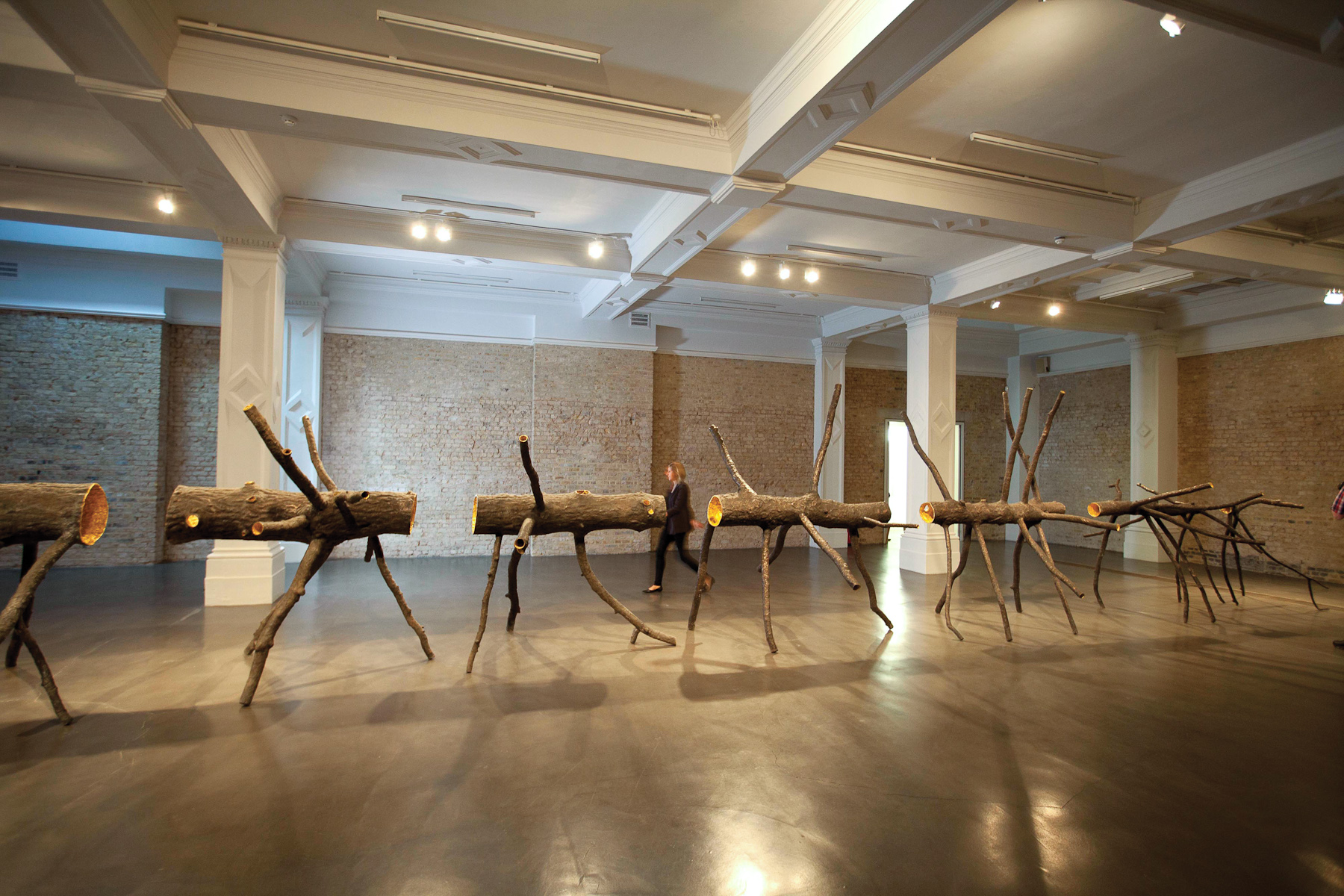
Giuseppe Penone, Spazio di Luce, 2012. Installation view, The Bloomberg Commission: Giuseppe Penone at Whitechapel Gallery, London. Photo: David Parry / PA Wire. © Giuseppe Penone.
Penone’s grand sculpture, Spazio di Luce (Space of Light), 2012, squeezed into Gallery 2 of the Whitechapel, presents a lost-wax casting in bronze of a wax mold built around a 40-foot larch. The exterior of the thin-walled shell reminds us that this is a reproduction of the hand-pressed finger-printed wax wads used to capture the surface features of the tree. The internal surface of the bronze mold, the part that would have been the bark, is gold-leafed to reflect light within the hollow that occupies the space of the tree. In this enlightened metaphor for loss as light, the larch’s sacrifice gives it an internal halo, light replacing life in both a radiant and melancholic displacement.
The tree is presented on its side, felled or fallen, and chopped up into body-sized segments, each held aloft by the branches. If the tree had not been sliced thus, we could not look inside at the impression of the bark or weave our bodies through the pieces. The revelation is magical: the disappeared tree made of light and the framing mold made of bronze are equivalent. The object on display is both figure and ground, object and frame. The absent subject, the larch tree, is a portrait of fallen light.
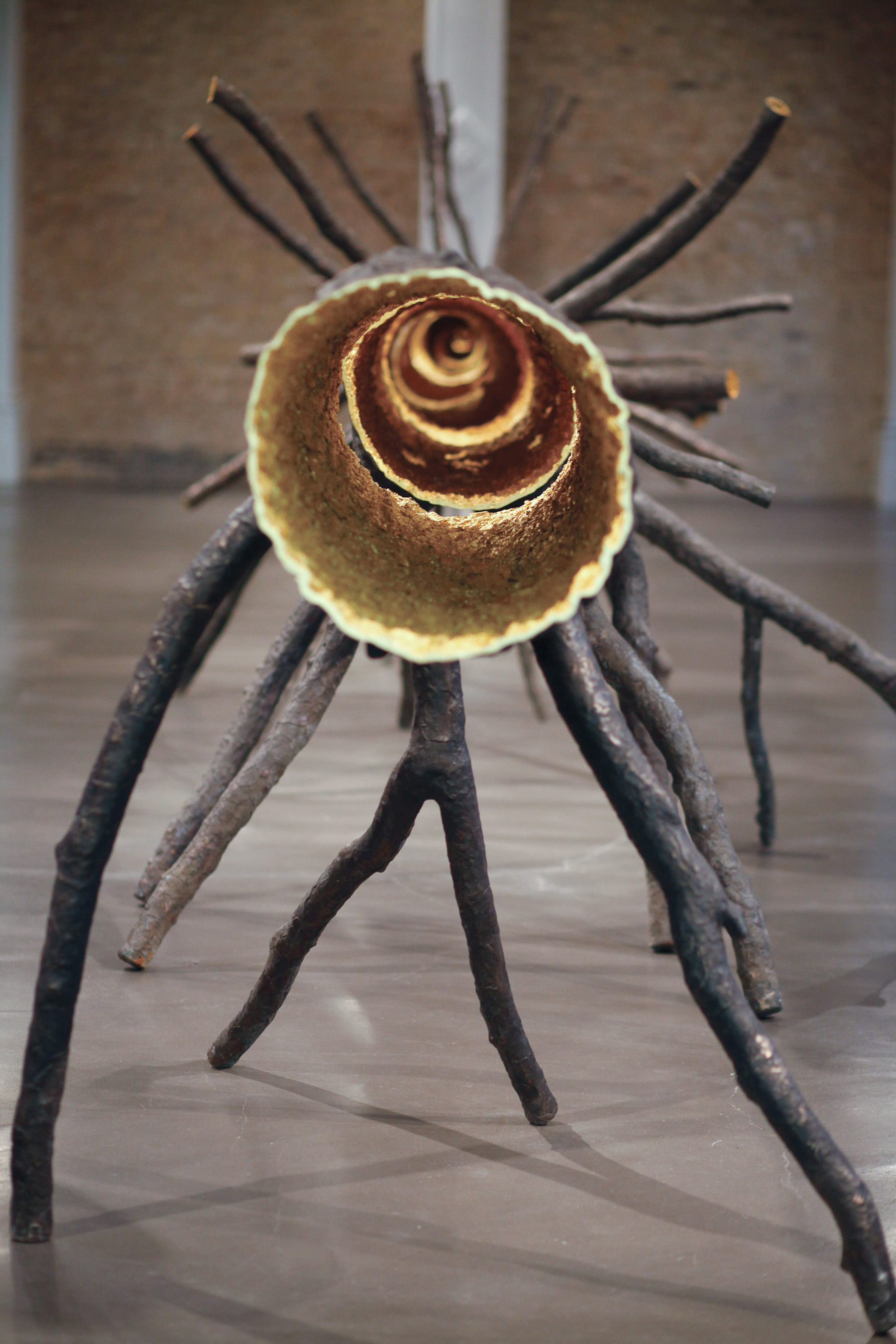
Giuseppe Penone, Spazio di Luce, 2012. Installation view, The Bloomberg Commission: Giuseppe Penone at Whitechapel Gallery, London. Photo: David Parry / PA Wire. © Giuseppe Penone.
Presented in a well-lit corner of the same gallery is Penone’s earlier piece, Essere Fiume (To Be River), 1998, where two seemingly identical boulders of Carrara marble, a favorite of stone sculptors in Europe, are placed side by side. One is a rock shaped by the forces of a Tuscan river, the other quarried and hand-shaped. The pairing underlines the analogical relationship of natural creation and artifice: Nature produces, man produces, artist repeats and reproduces. To pair Essere Fiume with Spazio di Luce points to the fact that the tree of light and the mold of bronze function as inverted copies, that Penone’s repetition can forestall the inevitable for a short while; but river-like forces will eventually erode the stone, and the larch remains fallen just the same. Deleuze’s reminder rings true: “Each art has its own imbricated techniques of repetition, the critical and revolutionary potential of which must reach the highest possible degree, to lead us from the dreary repetitions of habit to the profound repetitions of memory, and ultimately to the [symbolic] repetitions of death, through which we make sport of our own mortality.”11
Weber, Holloway, and Penone are remarkably diverse artists, yet all three fight a battle against material extinction using the tools of prostitution and forgery. In my heart I admire the clarity of Buren’s revolutionary post-studio thoughts and yet my own practice remains very much material and studio based. I would hope that we reactionaries can yet prevail by addressing the sculpture mold as sculptural body, the matrix as matter, and its particular effects and strategies. “[W]e observe two escapes from [any] body’s life cycle: on the one hand, the body inevitably wears out; on the other hand, it reproduces itself.”12 Maybe the use of molds as art points out the obvious, that no artwork is created out of nothing. Molds, like forgeries, recreate perception and history.
Toni Morrison states that invisible things are not necessarily “not-there,” that a void is not always a vacuum, and that certain absences are so stressed that they call attention to themselves and “arrest us with intentionality and purpose.”13 If sculptors from Rachel Whiteread to Juliana Cerqueira Leite solidify interiors, these artists hollow it out; what remains is an impression of loss, an exoskeleton from which the flesh has walked away, leaving a modern fossil behind.
Neha Choksi is an artist whose sculptural work treats molds as significant generative devices. She lives and works in Mumbai and Los Angeles.
